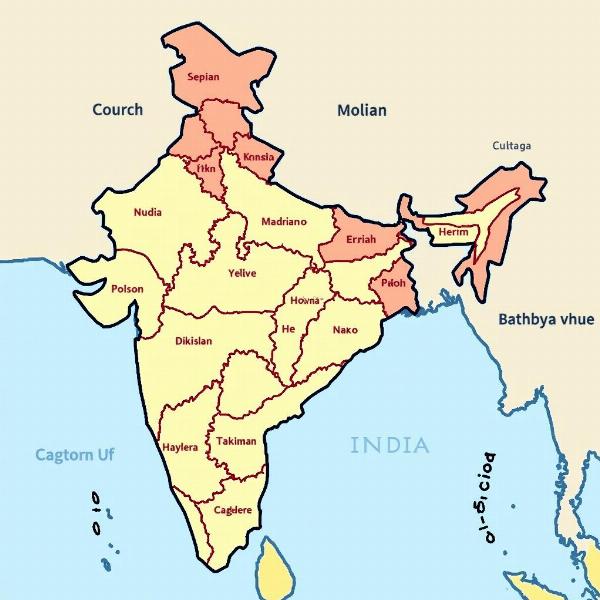The search for “hu in Hindi meaning” likely stems from a desire to understand the Hindi equivalent of the English pronoun “he.” Simply put, “वह” (vah) is the standard Hindi word for “he.” However, delving deeper into the nuances of Hindi grammar reveals a richer picture, encompassing variations based on formality, respect, and regional dialects. This article will explore the different ways to say “he” in Hindi, providing a comprehensive understanding of their usage and cultural context.
Different Ways to Say “He” in Hindi
While “वह” (vah) is the most common translation, other pronouns also convey the meaning of “he.” These variations often depend on the level of respect or formality you wish to express.
- वह (vah): This is the most common and neutral way to say “he.” It’s suitable for most situations and can refer to both animate and inanimate objects.
- यह (yah): This pronoun also means “he” but is typically used when the person is closer in proximity. Think of it as a “this he” rather than “that he.”
- ये (ye): The plural form of “यह” (yah), meaning “these.” It can be used to refer to a group of people including males.
- वो (vo): This is an informal version of “वह” (vah) and is commonly used in casual conversations. Avoid using it in formal settings or when addressing elders.
- ई (ee) / ऊ (oo): These are colloquial variations, primarily used in certain dialects and informal speech. Understanding their usage requires familiarity with specific regional nuances.
Formal vs. Informal Usage of “He” in Hindi
Choosing the right pronoun is crucial for conveying the appropriate level of respect in Hindi. Using “वो” (vo) with someone older or in a position of authority is considered disrespectful. Sticking with “वह” (vah) or using honorifics like “जी” (ji) appended to the name is generally preferred. For instance, instead of saying “vo kya karte hain?” (What does he do?), it’s more respectful to say “vah kya karte hain?” or address the person by name with an honorific, such as “Ram ji kya karte hain?”
Regional Variations of “He” in Hindi
The diverse landscape of India contributes to variations in Hindi dialects. While “वह” (vah) is understood across most regions, local dialects may have specific preferences. For example, the use of “ई” (ee) or “ऊ” (oo) might be common in certain areas but sound unfamiliar in others. Recognizing these variations can help you communicate effectively in different parts of India.
 Regional Variations in Hindi Pronouns
Regional Variations in Hindi Pronouns
Understanding the Gendered Nature of Hindi
Hindi is a gendered language, meaning nouns and pronouns have grammatical genders. This influences verb conjugations and adjective agreements. While “वह” (vah) primarily translates to “he,” it can also mean “she” or “it” depending on the gender of the noun it refers to. This is a key difference from English and requires careful attention to context.
Common Mistakes to Avoid
A common mistake learners make is using the incorrect pronoun based on gender or formality. Paying attention to the gender of the noun and the social context is crucial for accurate communication. Overusing informal pronouns can also come across as disrespectful.
Conclusion: Mastering the Nuances of “He” in Hindi
Understanding the various ways to say “he” in Hindi goes beyond simple translation. It involves navigating the intricacies of grammar, respecting cultural norms, and appreciating regional dialects. By mastering these nuances, you can communicate effectively and build stronger connections with Hindi speakers. Using the correct pronoun demonstrates respect and understanding of the language’s cultural context. Therefore, knowing when to use “वह” (vah), “यह” (yah), or other variations is vital for clear and respectful communication.
FAQ:
- What is the most common way to say “he” in Hindi? The most common way is “वह” (vah).
- Is “वो” (vo) polite to use? “वो” (vo) is informal and should be avoided in formal settings or when addressing elders.
- Does the gender of the noun affect the pronoun? Yes, Hindi is a gendered language, so the pronoun must agree with the noun’s gender.
- What are some regional variations for “he”? Some regions use “ई” (ee) or “ऊ” (oo) informally.
- Why is it important to use the correct pronoun? Using the correct pronoun shows respect and understanding of Hindi’s cultural context.
Meaning-Hindi.in is your trusted partner for accurate and culturally sensitive Hindi translation services. We specialize in various domains, including business, legal, technical, website localization, and academic translations. Our team of expert linguists ensures that your message is conveyed effectively and respectfully in Hindi. Need help with your Hindi translation project? Contact us at [email protected] or call us at +91 11-4502-7584. Meaning-Hindi.in is here to bridge the language gap for you.